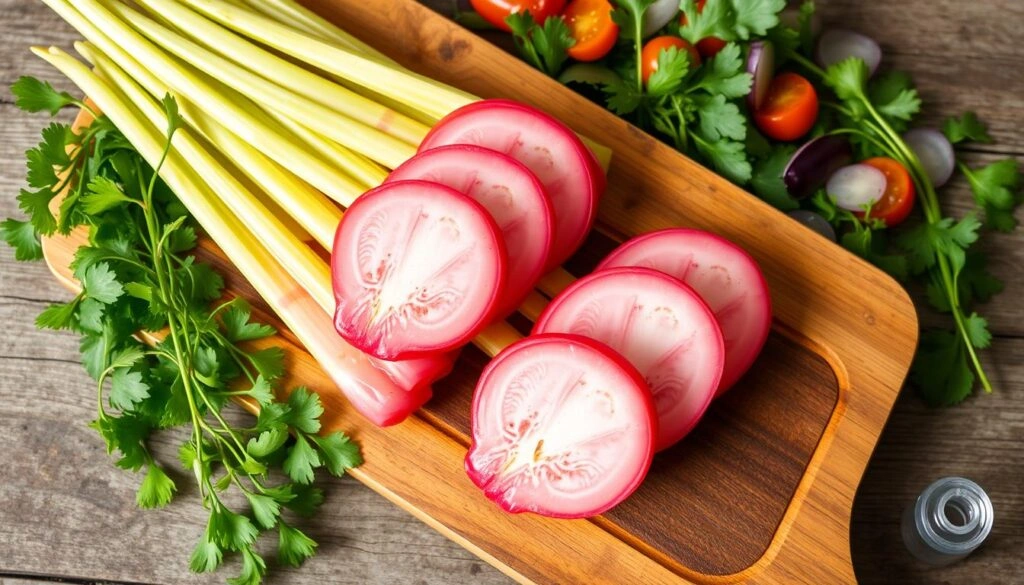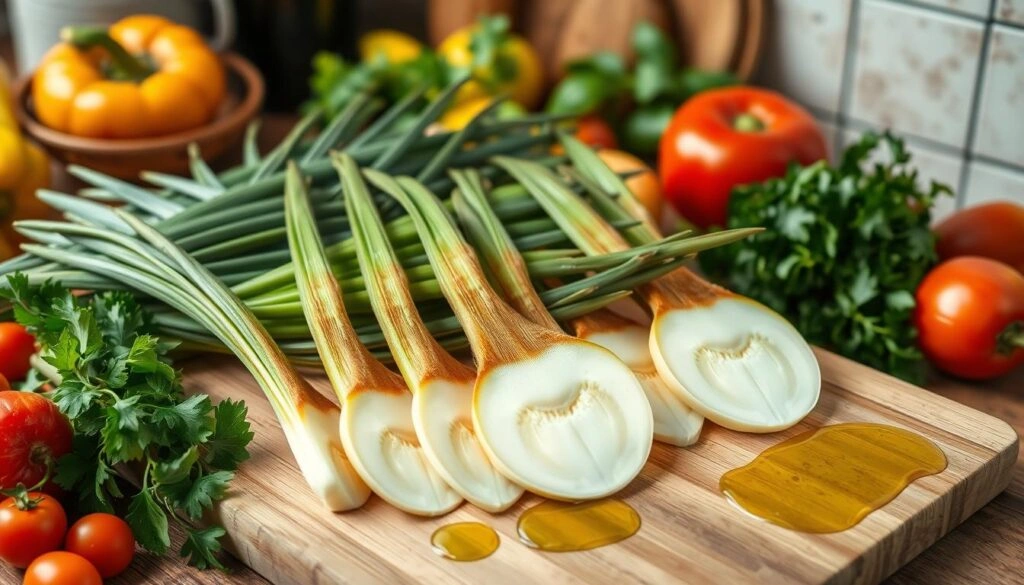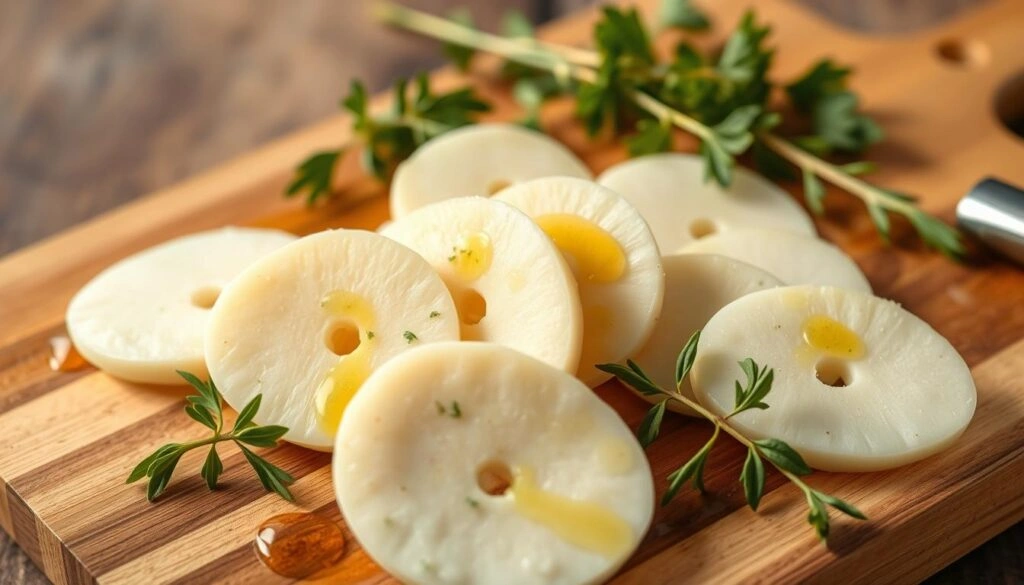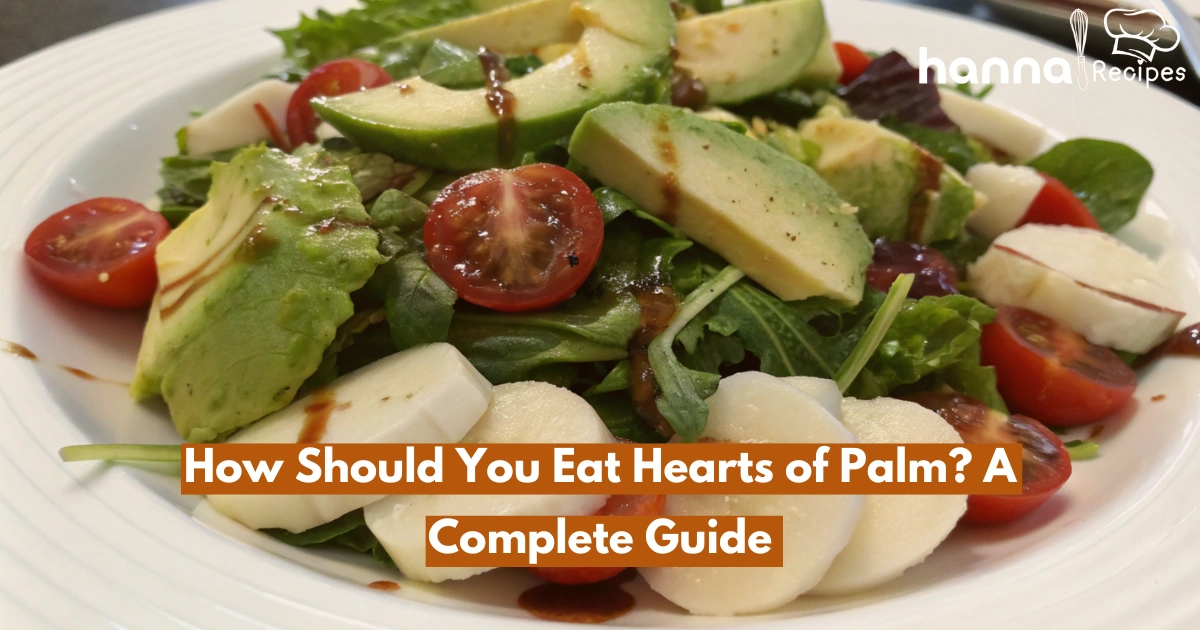Hearts of palm are a tasty and healthy treat that many wonder how to eat. This guide is for both experts and newcomers. It will show you how to enjoy the unique taste and texture of hearts of palm.

Key Takeaways
- Hearts of palm are a versatile and nutrient-dense vegetable that can be enjoyed raw, cooked, or incorporated into a variety of dishes.
- Proper preparation and cooking techniques are essential to bring out the best flavors and textures of hearts of palm.
- Hearts of palm can be used in salads, hot dishes, as a meat substitute, and paired with a wide range of complementary ingredients.
- Paying attention to storage and preservation methods can help ensure the freshness and quality of hearts of palm.
- Consideration should be given to any dietary restrictions or special dietary needs when incorporating hearts of palm into your meals.
Understanding Hearts of Palm: A Nutritious Delicacy
Hearts of palm are a unique and versatile ingredient. They offer a range of dietary benefits. This delicate vegetable comes from the inner core of certain palm trees. It’s prized for its unique flavor and versatile use in the kitchen.
Nutritional Profile and Health Benefits
Hearts of palm are packed with essential vitamins and minerals, including vitamin C, B vitamins, potassium, and magnesium. If you’re wondering how you should eat hearts of palm, rest assured they’re a healthy choice. They’re low in calories and fat, making them an excellent addition to any diet. Whether you choose to eat them raw or cooked, how you should eat hearts of palm depends on your recipe and personal preference, but the nutritional benefits remain the same.
They are a good source of fiber. This supports digestive health and helps you feel full.
Where Hearts of Palm Come From
The hearts of palm come from the inner core of certain palm trees. These include the Açaí palm and the Pupunha palm. They are native to tropical regions of South and Central America.
For centuries, they have been a staple in local cuisines.
Common Market Forms
Hearts of palm can be found in different forms in the market. Here are a few:
- Fresh, whole hearts of palm
- Canned or jarred hearts of palm, often in brine or water
- Frozen hearts of palm, for convenient storage and preparation
- Pre-sliced or julienned hearts of palm, ready for immediate use
Regardless of the form, hearts of palm keep their unique flavor and versatile nature. They are a valuable addition to many dishes.

Preparing Hearts of Palm for Cooking
Getting the most out of hearts of palm requires care and attention. To ensure you’re maximizing their flavor and texture, it’s important to know how you should eat hearts of palm. Before cooking, it’s crucial to clean and prepare them properly. Let’s explore the steps to master how you should eat hearts of palm, from preparation to cooking, ensuring they taste their best in any dish.
- Begin by rinsing the hearts of palm under cool water. Remove any tough outer layers or fibrous ends carefully, without harming the tender core.
- After cleaning, use a sharp knife to cut the hearts of palm into the desired shapes and sizes. Uniform pieces help with even vegetable preparation and cooking.
- If the hearts of palm are long, cut them in half lengthwise for easier handling.
- For dishes where you want to show off the hearts of palm, leave them in larger, rustic chunks. For salads or stir-fries, thinner slices or bite-sized pieces are better.
Now that your hearts of palm are prepped, you can add them to many tasty recipes. Try them in Southeast Asian-inspired brown rice dishes, fresh salads, or vibrant stir-fries. Remember to handle these vegetable delicacies with care for culinary success.
“Hearts of palm are a true treasure in the plant-based world, offering a versatile and nutritious ingredient that can elevate any dish.”

Preserving Freshness
To keep your hearts of palm fresh and at their best, use them soon after buying or preparing. If you have leftovers, store them in an airtight container in the fridge. They’ll stay fresh for up to 5 days.
How Should You Eat Hearts of Palm?
Hearts of palm are a tasty and versatile ingredient. You can enjoy them raw, cooked, or at different temperatures. There are many ways to savor this nutritious delicacy.
Raw Consumption Tips
Eating hearts of palm raw is refreshing. Simply slice them into thin rounds or strips. Add them to salads, crudité platters, or enjoy as a snack.
Their crisp texture and mild, sweet taste are delightful. Raw hearts of palm are a great addition to your meals.
Basic Cooking Methods
- Sautéing: Slice or dice the hearts of palm and sauté them in a pan with a bit of oil or butter until lightly browned and tender.
- Grilling: Brush the hearts of palm with oil and grill them over medium-high heat, turning occasionally, until charred and caramelized.
- Roasting: Toss the hearts of palm with olive oil, salt, and pepper, then roast them in the oven at 400°F (200°C) until they are tender and lightly golden.
Serving Temperature Options
Hearts of palm can be enjoyed at various temperatures. Serve them cold in salads or as a refreshing side dish. For a warm option, sauté or roast them and serve hot.
You can also serve them at room temperature. This allows their delicate flavors to shine through.
Hearts of palm are versatile and delicious. They can be used in many dishes, from fresh salads to hot entrées. Explore different ways to enjoy this nutritious delicacy and enhance your cooking.
Popular Hearts of Palm Serving Suggestions
Hearts of palm are great in many dishes, from appetizers to main courses and sides. They’re a nutritious veggie that adds unique flavor to meals. There are lots of ways to use them.
Appetizers and Snacks
Hearts of palm are perfect for appetizers or snacks. Slice them into discs and serve with a creamy dip. Or mix them into a refreshing ceviche or salsa.
For something heartier, sauté them with garlic and spices. Serve on toasted baguette slices.
Salads and Side Dishes
Hearts of palm are great in salads, adding crunch and a mild flavor. Mix them with greens, fruits, nuts, and a light vinaigrette. They’re also good with roasted veggies, rice, or quinoa.
Main Course Meals
Use hearts of palm in main dishes for a tasty and healthy meal. They can be sautéed, grilled, or baked. Serve them as the main dish or as a meat substitute in vegetarian or vegan recipes.
Try them in stir-fries, pasta dishes, or as a pizza topping.
| Serving Suggestion | Description |
|---|---|
| Appetizers and Snacks | Sliced discs with dip, ceviche, or sautéed on toasted bread |
| Salads and Side Dishes | Mixed into green salads, paired with roasted vegetables or grains |
| Main Course Meals | Sautéed, grilled, or baked as a meat substitute or main ingredient |
Hearts of palm are versatile and mild, yet distinct. They open up a world of possibilities in palm heart recipes. Try different cooking methods and flavors to find your favorite ways to enjoy them.
Creating Fresh Salads with Hearts of Palm
Hearts of palm are perfect for making vibrant, healthy salads. They add a unique flavor to any dish. Whether it’s a light lunch or a side, they make meals better.
Essential Salad Combinations
Try mixing hearts of palm with crisp greens, juicy tomatoes, and a zesty vinaigrette for a healthy dishes option. Or, mix them with avocado, cucumber, and a creamy dressing for a creamy, crunchy salad. Experiment with different textures and flavors to find your favorite.
- Hearts of palm, mixed greens, cherry tomatoes, and a balsamic vinaigrette
- Hearts of palm, avocado, cucumber, and a creamy lemon dressing
- Hearts of palm, bell peppers, red onion, and a zesty Italian dressing
Dressing Recommendations
The unique flavor of hearts of palm goes well with many dressings. Try a citrus-based vinaigrette or a Greek-inspired lemon-herb dressing for a light taste. For something richer, ranch or blue cheese dressing works well. Choose a dressing that lets the hearts of palm shine.
“Hearts of palm add a delightful crunch and subtle sweetness to any salad. They’re a game-changer for creating healthy dishes that are both nutritious and delicious.”
Incorporating Hearts of Palm into Hot Dishes
Hearts of palm are great for many hot dishes. They can be used in soups, stir-fries, and baked recipes. Follow our cooking instructions and palm heart recipes to make your dishes better.
Hearty Soups and Stews
Use sliced or diced hearts of palm to make soups and stews better. They go well with tomatoes, beans, and greens. They add crunch and nutrition.
Sizzling Stir-Fries
Thinly sliced hearts of palm are perfect for stir-fries. Cook them with veggies, protein, and spices for a tasty mix.
Baked Goodness
Hearts of palm are great in baked dishes like gratins and quiches. They add a creamy texture that goes well with many ingredients.
| Cooking Method | Recommended Preparation | Ideal Serving Temperature |
|---|---|---|
| Soups and Stews | Sliced or diced | Hot |
| Stir-Fries | Thinly sliced | Hot |
| Baked Dishes | Chopped or whole | Hot or warm |
Try using hearts of palm in your hot dishes. Enjoy the unique flavors and textures they add.
Hearts of Palm as a Meat Substitute
Hearts of palm are not just healthy and flexible; they are also a fantastic meat substitute for vegans and vegetarians. If you’re wondering how you should eat hearts of palm, their firm texture and mild, sweet taste make them a perfect alternative to chicken, beef, or seafood. Whether you’re using them in tacos, stir-fries, or as a main dish, knowing how you should eat hearts of palm can elevate your plant-based meals with delicious flavor.
Vegan Recipe Ideas
Hearts of palm are perfect for many vegan dishes. You can make vegan crab cakes, fish tacos, or even pulled “pork” sandwiches with them. Their neutral taste lets them soak up flavors well, making them a great vegan option.
Texture and Flavor Profile
The texture of hearts of palm is unique. It’s firm and meaty, just like animal proteins. Their mild taste can also be enhanced with herbs, spices, and sauces, fitting any taste.
| Texture Comparison | Flavor Profile |
|---|---|
| Firm and meaty, similar to chicken or fish | Mild, slightly sweet with a subtle nutty undertone |
“Hearts of palm are a game-changer for vegans and vegetarians looking to recreate the texture and flavor of animal-based proteins in their dishes.”
Storage and Preservation Tips
Keeping hearts of palm fresh is crucial. They add a nice crunch and flavor to many dishes. Knowing how to store them properly is important, whether they’re fresh or canned.
Storing Fresh Hearts of Palm
Keep fresh hearts of palm chilled and moist. Store them in the fridge in a sealed bag or wrapped in a damp paper towel. This keeps them crisp and prevents them from getting soggy or discolored. Use them within 3-5 days for the best taste.
Preserving Canned Hearts of Palm
Canned hearts of palm are easy to store and last longer. After opening, put the leftovers in an airtight container and refrigerate. They stay fresh for up to a week. Unopened cans can be stored for up to a year in a cool, dry place.
| Storage Method | Shelf Life |
|---|---|
| Fresh hearts of palm (refrigerated) | 3-5 days |
| Canned hearts of palm (unopened) | Up to 1 year |
| Canned hearts of palm (opened and refrigerated) | Up to 1 week |
By following these tips, your hearts of palm will stay fresh and tasty. They’re perfect for a variety of dishes that will impress your guests.
Pairing Hearts of Palm with Other Ingredients
Hearts of palm have a special taste that goes well with many ingredients. They’re great in salads or hot dishes. Learning how to pair them can make your food taste even better and show off their unique flavor and healthy qualities.
Complementary Flavors
Hearts of palm taste a bit nutty and mild. They go well with:
- Citrus fruits like lemon, lime, or orange for a fresh taste
- Aromatic herbs like basil, cilantro, or dill for more flavor
- Creamy things like avocado, yogurt, or cheese for a smooth feel
- Roasted nuts or seeds for a nice crunch
Wine Pairing Suggestions
For wine, hearts of palm need something light and crisp. Try these:
| Wine Type | Recommended Pairings |
|---|---|
| Sauvignon Blanc | The citrus and herbal notes in Sauvignon Blanc match hearts of palm’s unique flavor. |
| Pinot Grigio | Pinot Grigio’s clean, crisp taste goes well with healthy dishes with hearts of palm. |
| Rosé | Rosé’s fresh, lively taste pairs well with hearts of palm’s delicate nature. |
Pairing hearts of palm with the right ingredients and wines opens up new cooking possibilities. It highlights their unique flavor and healthy aspects.
Common Mistakes to Avoid When Preparing Hearts of Palm
Cooking with hearts of palm is a joy, but you must avoid common mistakes. These errors can ruin the flavor and texture. By avoiding them, you can make your dishes better and enjoy this versatile vegetable more.
One big mistake is overcooking the hearts of palm. They become tough and stringy if cooked too long. To keep them tender, cook them quickly and avoid boiling or simmering for too long.
- Properly Prepping the Vegetable: Clean and trim the hearts of palm well before cooking. This prevents tough or fibrous parts that can make the texture chewy.
- Avoiding Excessive Seasoning: Hearts of palm have a mild taste. Too much seasoning can overpower them. Use gentle spices and herbs to enhance their natural flavor.
- Incorrect Cutting Technique: Cut the hearts of palm into thin, even pieces. This ensures they cook evenly and stay in shape. Irregular cutting can lead to uneven cooking.
- Failing to Drain Properly: If using canned or jarred hearts of palm, drain and rinse them well. Excess liquid can make the flavor weak and the texture soggy.
By avoiding these common mistakes and following the right cooking instructions and vegetable preparation techniques, you can enjoy the full taste of hearts of palm. They add a delicate, fresh flavor to your dishes.
| Common Mistake | Proper Technique |
|---|---|
| Overcooking | Monitor cooking time and avoid prolonged heat |
| Inadequate Prepping | Thoroughly clean and trim the hearts of palm |
| Heavy-Handed Seasoning | Use gentle spices and herbs to complement the flavor |
| Incorrect Cutting | Slice into thin, uniform pieces for even cooking |
| Failing to Drain | Drain and rinse canned/jarred hearts of palm thoroughly |
“Mastering the art of preparing hearts of palm is the key to unlocking their full flavor and texture potential.”
Special Dietary Considerations and Restrictions
Hearts of palm are great for many diets, including vegan and low-carb. They fit well into different eating plans. This makes them a versatile choice for your meals.
Vegetarians and vegans will love hearts of palm. They’re a plant-based, meat-free option. You can use them in salads, main dishes, and more. Their mild taste and firm texture work well in many recipes.
For those watching carbs, hearts of palm are a good choice. They have few carbs, fitting into keto, paleo, or low-carb diets. They’re also high in fiber, helping you feel full longer.
| Dietary Consideration | Suitability of Hearts of Palm |
|---|---|
| Vegan | Excellent |
| Vegetarian | Excellent |
| Low-Carb | Excellent |
| Gluten-Free | Excellent |
| Paleo | Excellent |
Hearts of palm are nutritious and fit many diets. They offer dietary benefits and are perfect for vegan options. They’re a great choice for anyone looking to eat healthy.
FAQ
What are the best ways to eat hearts of palm?
Hearts of palm can be enjoyed in many ways. You can eat them straight from the can or jar. Or, slice them for salads, sauté them in stir-fries, or add them to soups and pasta dishes.
What are the nutritional benefits of hearts of palm?
Hearts of palm are very nutritious. They are low in calories and high in fiber. They also have vitamins and minerals like potassium, vitamin C, and B vitamins. Plus, they have antioxidants and anti-inflammatory compounds for health benefits.
How should you prepare hearts of palm for cooking?
To prepare hearts of palm, rinse them and remove tough outer layers. Then, slice, dice, or julienne them for your recipe. Canned or jarred hearts of palm are already cleaned and ready to use.
Can you eat hearts of palm raw?
Yes, hearts of palm are great raw. They have a crisp texture and a mild, sweet flavor. Thinly slice or julienne them for salads, crudité platters, or as a snack.
What are some popular ways to serve hearts of palm?
Hearts of palm are versatile. Use them in fresh salads, as a meat substitute, or sauté them with vegetables. They also work well in pasta, rice, and grain dishes.
How can you incorporate hearts of palm into salads?
Hearts of palm are perfect for salads. They go well with greens, fruits, and vegetables. Try them with avocado, tomatoes, cucumber, citrus fruits, and a light dressing.
Can you use hearts of palm in hot dishes?
Absolutely! Hearts of palm are great in soups, stir-fries, casseroles, and baked dishes. They keep their texture and add flavor and crunch to your meals.
How can hearts of palm be used as a meat substitute?
Hearts of palm are a great meat substitute. Their firm texture and neutral flavor make them perfect for vegan and vegetarian dishes. Use them in tacos, burgers, or as a plant-based “crab” or “lobster” substitute.
How should you store and preserve hearts of palm?
Store fresh hearts of palm in the fridge, in water or wrapped in a damp paper towel. Canned or jarred hearts of palm can be stored in the pantry. Once opened, refrigerate and use within a few days. Proper storage keeps their texture and flavor.
What flavors and ingredients pair well with hearts of palm?
Hearts of palm’s mild flavor pairs well with many ingredients. They go great with citrus fruits, avocado, tomatoes, herbs, and tangy dressings. For hot dishes, try pairing them with garlic, ginger, soy sauce, and savory flavors for balanced flavors.
Conclusion
Exploring hearts of palm shows they’re a great addition to your cooking. You can enjoy them raw, in salads, or in hot dishes. They add a unique and healthy touch to your meals.
Hearts of palm have a crisp texture and mild taste. They can make any dish better, from Caesar salads to vegan recipes. Keep trying new ways to use them and enjoy their versatility.
Start using hearts of palm in your cooking today. Try different recipes and see how they pair with other foods. This will open up a world of flavors and health benefits.


2 thoughts on “How Should You Eat Hearts of Palm? A Complete Guide”